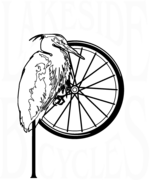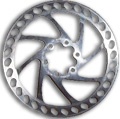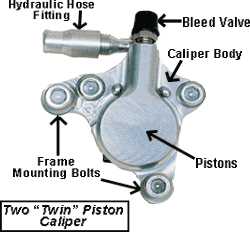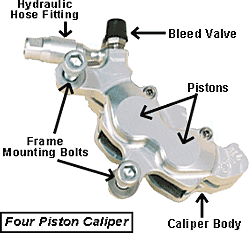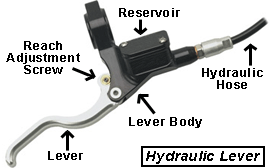|
|
|
Trickling down from the motocross world, disc brakes have now become popular on off-road bicycles. Discs provide powerful and reliable braking in all types of weather and terrain so they're ideal for trail riding. Plus, unlike rim brakes, discs aren't compromised should you hit a hole or land hard and bend your wheel.
Unlike the soft rubber pads used on rim brakes, discs use hard metallic- or ceramic-based pads that are less affected by water, mud and heat to achieve more consistent braking power. Additionally, some disc brakes use hydraulics (instead of cables); for even greater stopping power. |
Types
|
Mechanical Disc Brakes |
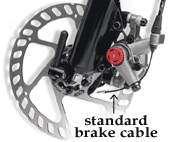 Mechanical discs use the same cables and housing found on traditional cantilevers and V-brakes. Cables offer certain advantages over hydraulic systems, including simpler installation and adjustment, lighter weight, and less complicated maintenance (cables can be found at any bike shop and are less expensive than hydraulic lines). Mechanical discs use the same cables and housing found on traditional cantilevers and V-brakes. Cables offer certain advantages over hydraulic systems, including simpler installation and adjustment, lighter weight, and less complicated maintenance (cables can be found at any bike shop and are less expensive than hydraulic lines). The main drawback to mechanical brakes is cable stretch, which causes a spongy feel, reduces braking power, and forces more frequent adjustment. Cables and housing are also susceptible to rust, dirt, and debris buildup that can bind the braking system. These problems are completely avoidable though. And the basic maintenance tips that we offer here will keep your mechanical discs strong and reliable. |
|
Hydraulic Disc Brakes |
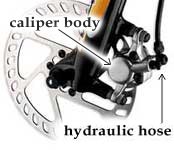 Hydraulic discs feature a closed system of hoses and reservoirs containing special hydraulic fluid to operate the brakes. When the lever is activated, a plunger pushes the fluid through the hoses and into the caliper where the pads are pushed onto the rotor, stopping the bike. Hydraulic discs feature a closed system of hoses and reservoirs containing special hydraulic fluid to operate the brakes. When the lever is activated, a plunger pushes the fluid through the hoses and into the caliper where the pads are pushed onto the rotor, stopping the bike. The advantage of hydraulic systems is being sealed (or "closed") so that water, dirt or debris can't compromise the brakes, making them very maintenance free once they've been properly installed. Also, hydraulic brakes have a silky smooth feel at the lever and incredible gripping power at the business end. For drawbacks, hydraulic brakes must withstand extremely high pressure, so expert set-up and frequent inspections are essential. The smallest air bubble or leak in hydraulic discs can cause a loss of power or complete failure. And, the process of removing air from the braking system, called "bleeding," varies between individual systems and can be a delicate process. So it's best to bring your bike in and have us help. |
|
The Two Types of Calipers |
|
|
|
|
Maintenance and Troubleshooting
| NOTE: While disc brakes work wonderfully even in extreme conditions, it's still important to keep them in tip-top shape. Following are basic suggestions. Different types of discs may require specific maintenance not covered here. One basic tip isbe careful not to squeeze your brake lever when removing your wheels. The pads will contract and you won't be able to get the wheel back in. Also, when replacing any parts or fluids, it's crucial to make sure everything is compatible. And, because brakes are so important for safety, we do not recommend working on them unless you’re confident in your ability to do the job right. If you have any questions about disc brake adjustment please call or bring your bike in and we'll be happy to help. Inspecting And Cleaning The Rotors Dirty, warped, cracked or otherwise damaged rotors are a common cause of brake failure. Rotors are rarely perfect, but if you find excessive wobbling (more than 1mm), cracks or gouges in your rotors, replace them immediately. A significant loss of braking power can also be caused by dirty or oily rotors or pads. Clean rotors and pads using only isopropyl alcohol. Other cleaners/degreasers can contaminate and damage the rotors or pads. If cleaning does not restore your braking power, replace the pads immediately. Squealing or noisy brakes is another common problem. It can be caused by loose bolts so start by checking all the bolts on the rotors and those attaching the calipers to the bike. Dirty pads may cause noise, too, so keep them clean. Still squealing? Check the alignment of the calipers over the rotors (see "centering the calipers" below). To check the rotors for dents or warping, spin the wheel and watch the rotors as they rotate past the pads. As long as the rotor does not rub, a slight lateral movement is acceptable. If the rotor rubs the pad in a spot, tap it lightly with a rubber or plastic hammer, or place a clean rag over the rotor and bend it slightly with an adjustable wrench. It doesn't take much, so don't overdo it! And remember: Never touch the braking surface of the rotor or pads with your bare hands because the oils on your fingers can decrease braking power.
Checking Brake Pad Wear 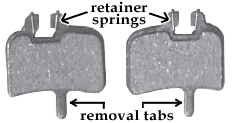 Removal: With the wheels removed, use your fingers or needle-nose pliers to grab the removal tabs extending below the inner brake pad (photo). Depending on the brake system that you're using, pull one or both pads straight out and toward the center of the caliper body until they're completely removed. The pads may also have retaining springs or magnets holding them in place that may come out. Inspection: If the remaining padding is thinner than the thickness of a nickel, you'll need new pads after a few more rides. If the pads are thinner than a dime, change them immediately. Insert the new pads into the caliper body the same way they were removed, making sure that the pads sit fully inside the caliper body. Warning: Do not touch or spill any fluids on the pads as skin oils or other fluids can cause a loss of braking power. Centering The Calipers (Preventing Brake Drag) The rotors need to be centered in the calipers to maximize braking power, eliminate drag and minimize noise. Some brakes use shims or thin washers on the caliper mounting bolts. For these brakes, add or remove shims to center the caliper over the rotor. Another popular mounting system uses a two-part bracket 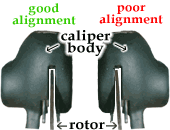 . To adjust the caliper position on these brakes, loosen the two centering bolts that attach the caliper to the mounting bracket, apply the brake lever and tighten the bolts. Hint: Try slipping business cards between the rotor and pads before applying the brakes to help center the calipers. . To adjust the caliper position on these brakes, loosen the two centering bolts that attach the caliper to the mounting bracket, apply the brake lever and tighten the bolts. Hint: Try slipping business cards between the rotor and pads before applying the brakes to help center the calipers. While applying the brake, it may also help to gently shake the caliper body so it comes to rest in a centered position, then tighten the mounting bolts. Finally, spin the wheel and check if the rotor is centered. Repeat the adjustments if necessary. Pre-Ride Check List
Now Go Ride! |
